|
|
|
Black Lives Matter Plaza
Saturday, October 17 2020
location: upper floor, Apartment [REDACTED], East Watergate Building, Washington, DC
[REDACTED]
In the room where we were staying in Gretchen's parents' Watergate apartment was shelf full of old VHS cassettes. To me, this seemed like a waste of valuable shelf space, given that all the media on that shelf could easily be translated to HD-quality video and easily fit on a single micro SD card that could be lost in the compartment of a wallet. But the size of a VHS cassette can, as we discovered this morning, also be an advantage. They are so big that their spines can have text that is readable from across the room. This was how we came to notice a VHS cassette of our 2003 wedding. Conveniently, there was a VHS-capable all-in-one media player nearby, so Gretchen popped in the cassette, and there we were, back in the first term of George W. Bush. Gretchen still had that mole near her right shoulder and I had no visible grey hair. We were young, and even Sally the Dog was young, and people were alive who have long-since died (an aunt, two uncles, Gretchen's great aunt, and a good many others). But as impressive as the youth or aliveness of everyone was how similar people were to the way they are now. Gretchen and I gushed over Sally in the same voice, using the same expressions, as we do with Ramona and Neville. And Gretchen's brother was acting exactly like he does today. There's a little sadness that comes with the awareness of the passage of time that come from such old videos, but there is also contentment in knowing that some things seem closer to timeless.
Down in the kitchen, Gretchen and her father were making faux-egg breakfast dishes using cutting-edge vegan products. I can't eat anything that pretends to have once been an agg, so instead I ate a bagel with faux cheese, faux-bacon crumble, and a slice of tomato. It would be the best thing I would eat today.
In the late morning, we had something to go to in Price Georges County, so the five of us piled into Gretchen's father's new all-electric car, a Hyundai Kona with a 300-mile range. It's supposedly even smaller than our Nissan Leaf, though we all fit reasonably comfortably. The Watergate officially has no 240 volt power anywhere (though this isn't actually true), and there isn't even 120 volts available in the parking garage. But Gretchen's father negotiated a deal with the businesses that live in the Watergate to tap into one of their outlet boxes (which was protected by a wire cage) so he can at least charge at 120 volts, a process that takes 70 hours to fill the entirely exhausted Kona battery.
Our destination was the University of Maryland at College Park, where a sculptor would be performing a melting of brass shell casings in a small gas-fired furnace. She would then re-cast the melted brass into a small bell using a sand mold. The idea here was a near-literal exercise of "guns-to-plowshares," and much of the artist's work concerns school shootings. Gretchen's parents had won our participation in this event in some sort of benefit auction, and (it being covid times) it would be outdoors, and it would just be the five of us and the artist.
We got to the building where we were to meet Mercedes, the artist, but we'd come to the wrong entrance at the wrong level, so she met us there and we walked around to service entrance to her studio, where, out in the roadway, one could safely melt a small amount of brass and recast it. Mercedes explained how things would be done, and then handed us each a single casing from a bucket of them she'd obtained from a police gun range. She then started up the furnace, which was powered by two 14 oz propane torches like the kind used for soldering. We were then asked to carefully drop our casings into the graphite crucible in the furnace while wishing for something non-violent. I didn't wish for anything, but Gretchen wished for some sort of vegan utopia. I know enough about metal arts to ask questions about things Mercedes might have otherwise neglected to mention, such as the nature of the crucible (graphite) or flux (borax). She characterized brass as a "nasty metal," though she didn't say that this was because of the unpleasant gases released when one heats zinc.
Once our shell casings began to melt, there was room for more, and Mercedes kept adding them as space in the crucible opened up (this reminded me of the beer can melting I've done in "bean can crucibles" in the woodstove, something I mentioned). Finally it was time to pour the molten brass into the nearby sand molds (which consisted of sand held together by a weak binding of an oil-based binder). Not long after the brass was poured, Mercedes broke open the molds and showed up the bells. They had thick walls and an arm of surplus brass, but they were beautiful and very unlike the source material. Gretchen's father offered to make a donation to the studio in exchange for both brass bells, one for Gretchen and me, and one for Powerful.
At that point, Mercedes decided to give us a tour of the studio, which would be okay (I suppose) it was just us and her and we would all be wearing masks. We saw a few projects in the big downstairs student studio, and then we took a massive room-sized elevator up to the top floor to see her smaller personal studio, where she had a number of works, including a display of 49 small aluminum bells made from a melted-down SIG Sauer MCX assault rifle to commemorate the 49 who had been killed in the Orlando nightclub shooting (where a SIG Sauer MCX was one of the weapons used). Mercedes had also made a series of exercising weights from aluminum, brass, and unmelted bullet casings cast in resin, and she'd taken photos of her girlfriend (a Lebanese-Armenian weightlifter) lifting these weights.
After that, the in-laws wanted to go to the center of the University of Maryland campus to show Powerful its massive Jeffersonian lawn (which looks to be bigger than its inspiration at the University of Virginia). One one end of the lawn were numerous well-spaced circles drawn in lime as a guide for social distancing, though we saw one group of young women all clustered together as if it were the old days.
From there, we went on a meandering path back into the District of Columbia from the northeast, stopping first in the quickly-gentrifying Union Market area. When Gretchen realized we'd be near Shouk, an all-vegan Isræli burger joint, she insisted on stopping there. It was a super-hip fast-casual restaurant, with lots of decayed urban materials used as decoration (such as rusted corrugated metal panels separating the kitchen area from the dining area). Shouk was still in pandemic pick-up-only mode, with all the chairs put up and a makeshift barricade to keep people from congregating near the bathrooms. Gretchen ordered three Shoukburgers, spicy fries, some sort of falafel-battered mushroom, and a fancy hummus dish, some of which we snacked on during the drive downtown.
We drove into the part of Washington where all the famous buildings are. We drove past a number of them, starting with the north end of the Capitol, then the Supreme Court, the Library of Congress, and then various Smithsonian buildings south of the National Mall. Eventually we parked the car cat the corner of Pennsylvania and 15th Street Northwest and tried to walk from there to the place along Pennsylvania Avenue just north of the White House. But Pnnsylvania Avenue was totally closed here, even to pedestrians, something my inlaws had never seen. A barricade of steel fencing had been expanded out from the White House to include all of Lafayette Square. So we walked to the corner of H Street Northwest and 16th Street Northwest, the closest one could get to the White House from the north. In this area a bunch of protestors, who appeared to be part of an effort that has continued since the George Floyd murder back on Memorial Day, mingled and handed out signs. We read the signs attached to the steel barricade and took what pictures we could, and then briefly ventured up 16th Street, past St. John's Episcopal Church (the one Donald Trump marched to after clearing peaceful protestors with pepper spray so he could pose with a bible back in June). North of there 1th Street has been renamed "Black Lives Matter Plaza" and is closed to traffic. The words "BLACK LIVES MATTER" have been painted in yellow on the street and nearby buildings (including one belonging to the AFL-CIO, as well as St. John's Church itself) fly flags in solidarity with the concept of Black lives mattering. Periodically we'd seen people carrying signs or pussy hats from a women's march that had happened earlier today.
Back in the Watergate, we hungrily devoured our shouk burgers even though it was already late afternoon and there would be a dinner soon. There ended up being hardly any time to prepare for that dinner before our guest for the evening arrived about a half-hour early. It was Andrea, Gretchen's childhood friend who lived for a couple months in our basement back in the summer of 2016. She'd been riding her electric bike (her means of low-cost personal transportation to avoid crowds on the Metro during the pandemic) and had evidently scheduled too much time. She came bearing an enormous amount of vegan sushi some friends of her had made.
I was unsure what the protocol would be when Andrea arrived, but it ended up being that she was considered covid-free for some reason, and Gretchen urged me to hug her just like in the old days. I'd thought we wouldn't be doing that sort of thing until the pandemic was over, and peer pressure of this sort is how the coronavirus exploits humanity, but I complied nonetheless.
With the exception of Gretchen, who doesn't like the nori seaweed it comes wrapped in, we ate sushi as Gretchen's mother came around with it. The combinations of components were a bit jarring, with an emphasis on sweet potato (which I hate) and mango (which seems out of place in a savory food) as well as tofu and avocado. But the biggest problem was the lack of pickled ginger and wasabi; the only condiment that came with it was soy sauce, and that's something you can usually find in your house (unless you're a hillbilly). Without those, my ability to enjoy the sushi was greatly diminished.
By dinner time, I was too full to have much interest in eating anything. Fortunately, it was served buffet-style, meaning I could tile a few leaves of salad lettuce on my plate to look like I was getting more food than I actually was. I also tried some of the faux beef wellington loaf Gretchen's father had made, but it was full of flavors I had no desire to taste (at least at the time) including fennel and orange zest.
Andrea comes from a Christian Scientist family, and she is still, one would say, "culturally" Christian Scientist. She even goes to services, which is easy now that they're all held remotely. Indeed, she can go to exactly the kind of service she prefers anywhere in the world. The one she's been going to, she explained tonight, is really into Black Lives Matter and defunding the police. This made me realize that the Zoomification and virtualization of meetings probably isn't going to go away after the pandemic does. By then we will have been trained to attend things remotely, and we won't settle for the rinky dink whatever held locally when your people are gathering in their diaspora online. Andrea also defended her religion against Gretchen's claims that it was completely opposed to medical intervention. Apparently this feature varies by congregation. For his part Powerful, who has a master's degree in theology, had never heard of Christian Science, an indication of how hard it is to get a complete view of the world from behind bars.
Later Powerful told those at the table all about his knowledge of various Nation of Islam splinter groups, a taxonomy that I've decided isn't particularly interesting. I was much happier when Gretchen's father brought the discussion around to the subject of the Metro's Purple Line, designed to be an east-west route passing near the northernmost tip of the District. Apparently Montgomery County had failed to pay contractors, and, after much demolition, they'd abandoned the project.
I ended the evening via a socially-acceptable social retreat: going into the kitchen and undertaking a massive dishwashing jihad.
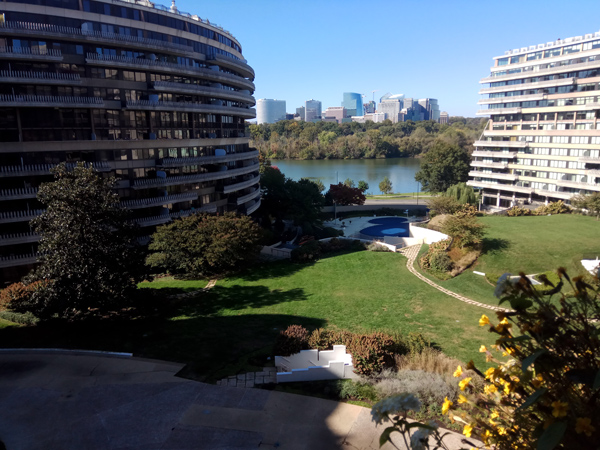
The view westward from the west balcony of Gretchen's parents' apartment. Those distant buildings are in Virginia. Click to enlarge.
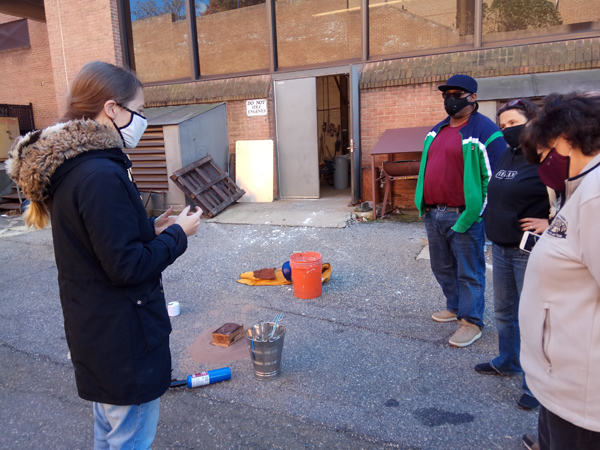
The casing-melting ritual in College Park. From left: Mercedes, Powerful, Gretchen, Gretchen's mother.
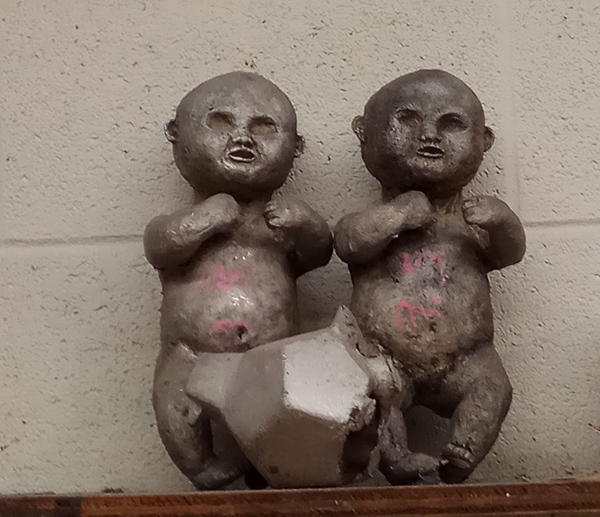
Cast babies in the large studio.
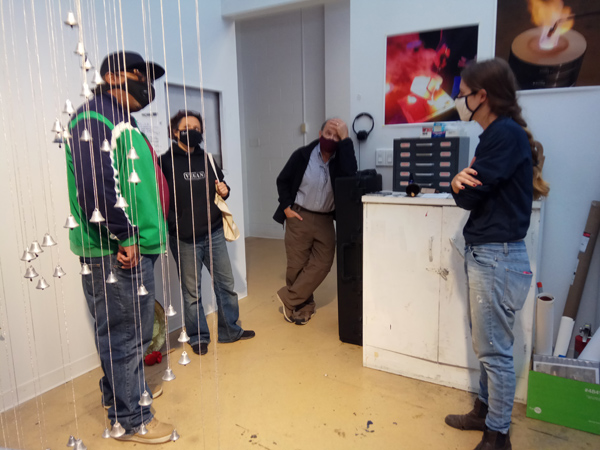
49 aluminum bells up in Mercedes' studio.
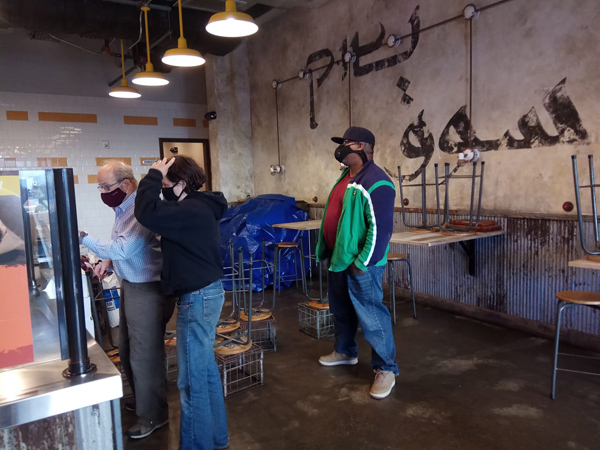
At Shouk today. From left: Gretchen's father, Gretchen, and Powerful. When people had trouble reading something in Hebrew, Powerful commented, "You're all fired!" Click to enlarge.
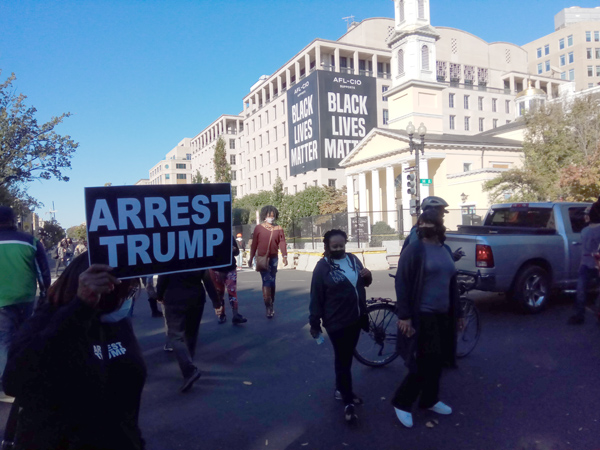
The church that Trump marched to at the south end of Black Lives Matter Plaza.
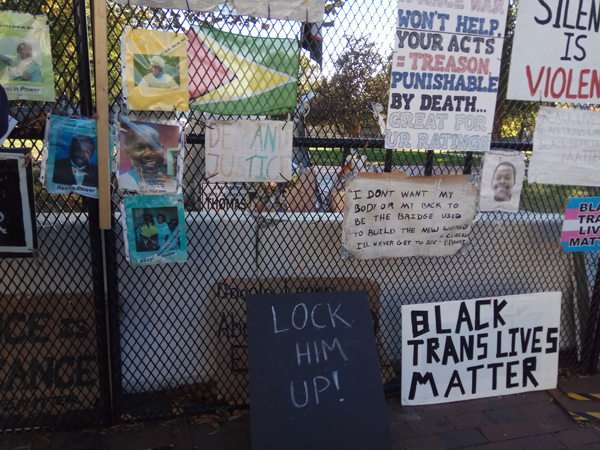
Signs on the fence on H Street Northwest.
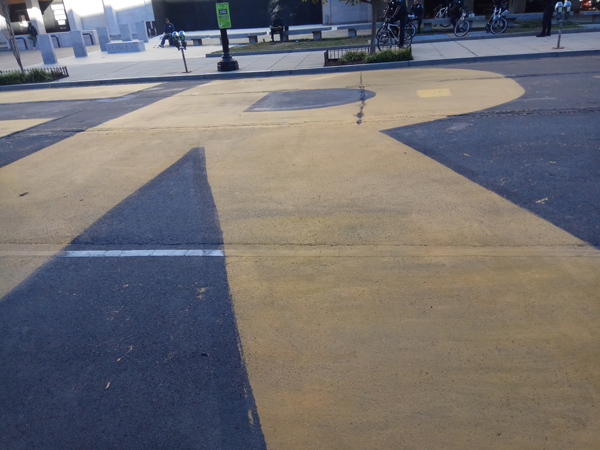
The final R in "BLACK LIVES MATTER."

Us posing for a photo at the H-Street fence. From left: Gretchen's mother & father, Gretchen, me, and Powerful. Click to enlarge.
For linking purposes this article's URL is:
http://asecular.com/blog.php?201017 feedback
previous | next |








